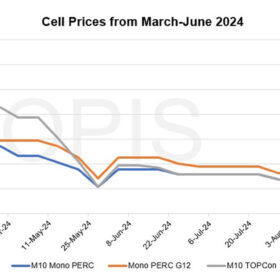The hidden potential of green energy stocks
The green energy sector in India has been showing strong performance, and so are the green energy stocks. And everyone wants a piece of the pie.
India’s hydrogen mission: Unleashing the power of green fuel
India’s hydrogen revolution is gaining momentum, but to fully realise its potential, the country must bridge the gap between production and demand. The government’s policies have successfully catalysed investments and spurred innovation, but future success will depend on driving consumption and scaling up both production and infrastructure.
Chinese solar cell prices stable in a quiet market
In a new weekly update for pv magazine, OPIS, a Dow Jones company, provides a quick look at the main price trends in the global PV industry.
How ESG creates value for companies in the renewable energy industry
Companies that embed ESG (Environmental, Social, and Governance) principles into their core strategies are better positioned for long-term resilience and competitiveness in the rapidly evolving renewable energy industry.
How innovations in electrolyzer technology are making green hydrogen more affordable
The cost-effectiveness of green hydrogen hinges on the efficiency and scalability of electrolysers. Historically, the high cost of electrolysers and the electricity required for water electrolysis have been significant barriers. However, recent technological innovations are addressing these challenges.
Increasing potential of silicon clathrate films for photovoltaics
Researchers led by scientists from CNRS in France are exploring an exotic form of silicon called silicon clathrate as a material for energy applications, including photovoltaics. Mastering the synthesis and using appropriate characterizations are key elements towards potential applications. Significant progress is being made for the fabrication of functional devices.
Wafer manufacturers extend efforts at price reversal
In a new weekly update for pv magazine, OPIS, a Dow Jones company, provides a quick look at the main price trends in the global PV industry.
Unlocking the potential of agrivoltaics
Agrivoltaics, the innovative practice of co-locating agriculture and photovoltaic (PV) systems, is revolutionizing sustainable land use and energy production. By harnessing the synergy between agriculture and solar energy, agrivoltaics offers a transformative solution to address the challenges of food security, water scarcity, and climate change. This article explores the burgeoning agrivoltaics market, its potential benefits, challenges, and future outlook.
Price range for US-delivered modules widens
In a new weekly update for pv magazine, OPIS, a Dow Jones company, provides a quick look at the main price trends in the global PV industry.
Solar industry faces collapse amid surplus and plunging prices
The solar industry is at a crossroads. While demand for PV installations is higher than ever, systemic overcapacity, falling prices, and financial losses across the supply chain threaten to undermine the industry’s long-term sustainability.














